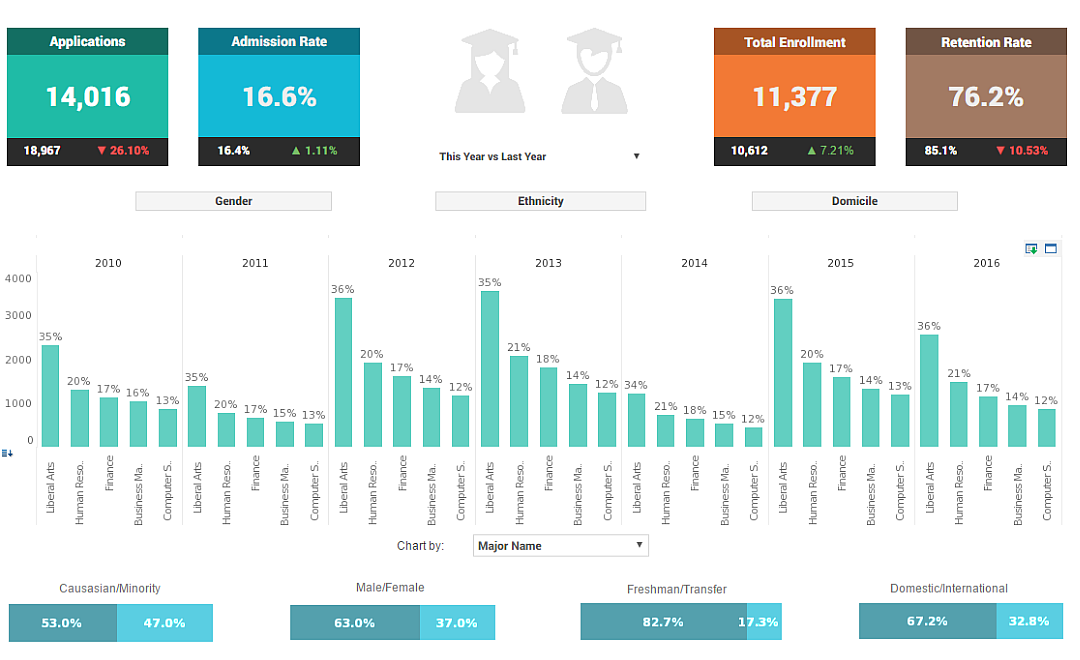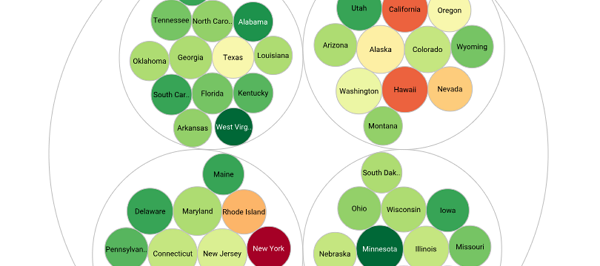InetSoft on DM Radio: The Next Generation of BI
This is the continuation of the transcript of DM Radio’s program titled “The Consumerization of Business Intelligence: How and Why.”
Eric Kavanagh: Yeah. It makes a lot of sense, and let’s use that as our sort of closing concept here, the next generation of BI. I guess first I will throw it out to Byron, as this consumerization trend sort of shakes out overtime, what do you see as the end result in a year or two years’ time?
Bryon Igoe: Sure. I think that we are going to see major advances in collaboration. Now that individual people have more self-service, we are going to start seeing teams building again, where groups of people can get together and analyze things more easily.
Eric Kavanagh: Great comment. And Francois, what about you, where are things going?
Francois Ajenstat: Well, I think it's a play on collaboration, but the next step of analysis is really to start sharing. And so, I am seeing this big trend around storytelling and using data to tell stories and really bringing people into the analysis or into the insights that you want to share.
What’s Next for BI?
Eric Kavanagh: That makes a lot of sense, too. And Tracie, what do you see, what’s the next big thing?
Tracie Kambies: I think it's a lot of sensing, both sensing of how people are responding to the information and I think more listening to what’s going on and how people are collaborating. I think that it's just about being able to interact with the data through all of our senses. And I think that’s where it's going. We are going to be able to consume more of that sensing information even from the end consumers to bring those learnings back into execution in the BI space.
Eric Kavanagh: Yeah. And Justin, I thought you made a really good point right at the top of the hour about the number of millennials that will be in the workforce in?
Justin Kern: I forget, where I think AIIM had a stat a couple of years ago, or last year. And it kind of speaks to what Tracie talked about earlier about the child with the Tablet, and I think that that intuitive sense of being able to take in data, to know you can collaborate, to want to collaborate with it, kind of speaks to this overall trend.
What Makes StyleBI Intuitive for End Users
In the world of business intelligence, technical sophistication often creates a barrier to adoption. Many platforms are powerful but overwhelm everyday business users who simply want to access insights without becoming database experts or software engineers. StyleBI sets itself apart because it is designed with usability as a core principle rather than an afterthought. It brings advanced analytical power into a user-friendly environment that lowers the learning curve and makes dashboard creation, data exploration, and report sharing accessible to a broad spectrum of employees. The emphasis is on allowing people to focus on insights rather than wrestling with complex tools.
One of the central aspects that makes StyleBI intuitive is its visual, drag-and-drop interface. End users do not have to memorize complex query syntax or manually write scripts to explore data. Instead, they can drag fields, metrics, and visualizations into place to build dashboards organically. This interface mirrors the natural way that most people think about information—assembling it visually and experimenting with different perspectives until the picture becomes clear. By reducing the dependency on technical staff for even basic report generation, StyleBI empowers employees at every level to take ownership of the data they need to do their jobs effectively.
Another factor that makes the platform approachable is its consistent design language across all modules. Users do not have to learn a different set of rules for dashboards, data mashups, or advanced analytics. The principles they learn in one area carry over seamlessly to others. This uniformity shortens the training period and builds confidence quickly, since users can predict how functions will behave even in areas they have not yet explored. A consistent design philosophy also helps organizations scale adoption across departments, because employees can help one another and share workflows without confusion.
StyleBI also integrates intuitive self-service options for exploring data in more depth. Once a dashboard is created, end users are not limited to viewing static charts. They can interact with filters, drill down into specific categories, and pivot metrics without needing to ask IT for a new report. This flexibility matters because the questions people ask of their data evolve constantly. By giving non-technical staff the power to follow their curiosity, StyleBI encourages more engagement with data. Over time, this interaction builds a culture of analysis where employees use information as a daily decision-making tool rather than as a static monthly report.
The platform’s emphasis on natural language elements also plays a role in its intuitiveness. Instead of dealing with obscure field names or database jargon, users interact with clearly labeled options that make sense in their business context. When fields and filters align with business terminology, the mental burden of translating between technical and operational language disappears. Employees can work directly with their familiar vocabulary, making insights feel more immediate and actionable. For managers and executives who may not have a technical background, this alignment is particularly important.
Another dimension of StyleBI’s intuitive design is how it handles collaboration. End users are not just building dashboards for themselves but sharing them with colleagues and stakeholders. The platform makes this process simple, with sharing options that feel as natural as distributing a document or slide deck. Access controls and permissions are integrated without being cumbersome, so users can confidently share insights knowing that the right people will see the right data. This emphasis on usability extends beyond the creation phase into the distribution phase, ensuring that insights flow freely through the organization without bottlenecks.
Mobile accessibility further strengthens the sense of intuitiveness. Today’s employees expect to check dashboards on their phones or tablets without needing a separate app or specialized training. StyleBI’s responsive design makes this possible, adapting dashboards to different screen sizes while preserving their interactivity. For an end user, this translates into a seamless experience across devices, removing the friction of switching contexts and ensuring that insights are always available. This adaptability fits naturally into the way modern professionals work and supports quicker decision-making in real time.
The onboarding process also contributes significantly to usability. Because StyleBI is designed for self-service, new users can often get started with minimal training. Guided workflows, helpful tooltips, and intuitive defaults mean that even first-time users can create meaningful dashboards with little outside assistance. As they gain comfort, they can explore more advanced features without feeling overwhelmed. The learning path feels natural, progressing from basic reporting to deeper analysis at the user’s own pace. This progressive disclosure of complexity ensures that the platform grows with the user rather than intimidating them from the start.
Beyond the interface, StyleBI makes a point of reducing cognitive overload through thoughtful design choices. Colors, charts, and layouts are selected with clarity in mind, avoiding unnecessary clutter that might distract from insights. Visualizations are not only aesthetically pleasing but also purposeful, helping users see patterns and relationships quickly. By emphasizing clarity over flashiness, StyleBI ensures that dashboards remain intuitive tools for analysis rather than decorative but confusing displays. This philosophy respects the time of end users by ensuring that the answers they seek are front and center.
Ultimately, what makes StyleBI intuitive for end users is its ability to balance power with simplicity. It provides access to sophisticated analytics capabilities, but it presents them in a way that aligns with how people naturally work with information. Users do not feel like they are learning a foreign language; they feel like the software is an extension of their own reasoning process. This alignment is what drives adoption, engagement, and long-term success. By removing friction from every stage of the data journey—building, exploring, and sharing—StyleBI turns business intelligence into something accessible and empowering for everyone in the organization.
Intuitiveness is not an accident but the result of deliberate design choices. StyleBI demonstrates that enterprise-level BI tools do not have to be intimidating or reserved for specialists. When usability is prioritized alongside analytical power, the outcome is a platform that people actually want to use. For organizations, this means higher return on investment and a more data-driven culture. For end users, it means the confidence and freedom to answer questions, test assumptions, and make informed decisions—all without feeling like they are wrestling with their software. In a marketplace crowded with BI solutions, this combination of simplicity and strength is what makes StyleBI stand out.




